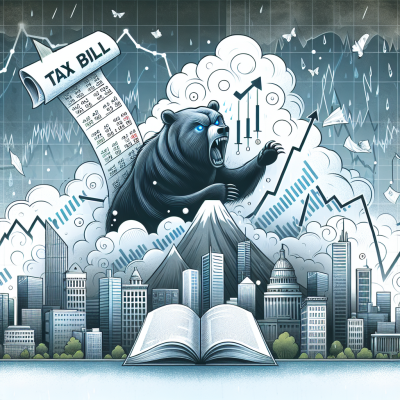
Market Jitters as U.S. Futures Slip and Bond Yields Rise
On Wednesday, concerns over U.S. fiscal policy took center stage on Wall Street as stock index futures edged lower and Treasury yields hit new highs. The instability came amid fresh Republican infighting surrounding former President Donald Trump’s proposed tax-cut bill, which has sparked intense debate within the GOP as the bill nears a crucial vote in Congress.
Wall Street Responds to Political Gridlock
Investor nerves are fraying as key fiscal measures hang in the balance. The Trump-backed tax package, touted as a major pro-growth policy, has encountered unexpected resistance from within the Republican party. Disagreements over the scale of the cuts and their potential impact on the ballooning federal deficit have caused delays, hurting investor sentiment across U.S. markets.
Market analysts say the uncertainty is causing significant short-term hesitation among traders, who are opting for safe havens over equity exposure.
Stock Futures Under Pressure
S&P 500 futures traded marginally lower during early morning hours, losing as much as 0.3%. Dow Jones Industrial Average futures slipped around 80 points, while Nasdaq 100 futures also tilted into negative territory. The retreat marked a notable pause following recent rallies driven by robust earnings reports and hopes for rate cuts later in the year.
Traders worry that any prolonged uncertainty in Washington could derail broader economic optimism and weigh on future earnings projections.
Bond Yields Climb Amid Budget Concerns
On the other end of the spectrum, U.S. Treasury yields continued their ascent, with the benchmark 10-year yield climbing to its highest level in weeks. The uptick reflects growing investor concerns over government debt and inflationary pressures tied to expansive fiscal policy.
- 10-Year Treasury Yield: Rose to 4.62%
- 2-Year Treasury Yield: Climbed above 5%
- 30-Year Treasury Yield: Approached 4.75%
Bond yields rise when asset prices fall, indicating a drop in demand for U.S. debt—a signal that investors may be bracing for widening deficits if the proposed tax changes go through.
Cracks Appear in Republican Unity
The Republican infighting is adding layers of uncertainty that markets typically dislike. Some party members have voiced concerns about the long-term fiscal sustainability of the tax package, especially with projections suggesting it could add as much as $3 trillion to the national debt over the next decade.
Recent polling shows that while Trump retains a strong grip on the Republican base, his economic agenda is facing growing skepticism among fiscally conservative lawmakers.
Standoff in Congress
As Congress prepares to vote in the coming weeks, the bill’s passage remains uncertain. Lawmakers remain split on whether the suite of proposed tax breaks will stimulate enough growth to offset the increased spending or whether they will deepen America’s debt woes.
“Markets are pricing in a higher risk premium,” said Michael Peterson, chief economist at Horizon Finance Group. “The political disarray and lack of fiscal coherence are starting to affect yield curves and equity pricing.”
What This Means for Investors
In the short term, the political standoff and rising bond yields may lead to greater stock market volatility. Investors may consider pivoting to value stocks, inflation-protected securities, or even increasing cash positions to weather potential fiscal headwinds.
Key Takeaways:
- Stock markets are highly sensitive to fiscal policy changes and political uncertainty.
- Rising bond yields reflect a shift in investor sentiment toward inflation and debt-load concerns.
- GOP infighting is heightening doubts about the tax bill’s viability.
- Investor strategy may need to adjust based on shifting fiscal terrain and Federal Reserve actions.
Looking Ahead: Volatility May Persist
As the fiscal drama in Washington unfolds, markets could see heightened swings—especially with added macroeconomic catalysts like inflation data, GDP figures, and further central bank commentary on the horizon. Whether a tax bill ultimately passes or not, this episode underscores the direct influence of government policy on financial markets.
Investors are advised to keep a close eye on developments from Capitol Hill in the days ahead. The shape of U.S. tax policy—and by extension, future market direction—may hinge on how this standoff is resolved.


Leave a Reply